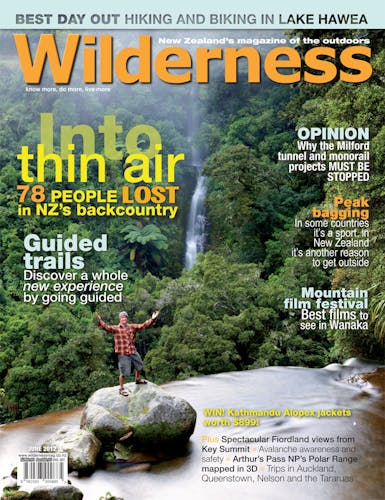The added weight of a person on a slope can cause unstable snow layers to fail like a house of cards with the result that hundreds of tonnes of snow can avalanche with potentially tragic consequences. Basic avalanche awareness will help you understand the avalanche phenomenon, the terrain on which they occur and the mechanics of unstable snow.
Here are eight fundamental tips to assist making safer choices in avalanche terrain.
1 Plan your trip
After determining your intentions and party ability, obtain information on current conditions from local sources. Check the ski field weather forecasts on the MetService web site. Particularly useful is their seven day precipitation forecast. Also look up www.avalanche.net.nz for regular winter avalanche advisories and adjust your plans accordingly.
2 Carry and know how to use avalanche rescue tools
This includes an avalanche transceiver, a snow shovel and an avalanche probe.
The latest safety item is an avalanche air bag – a pack with an air cylinder and buoyancy balloon which inflates when triggered to wrap around your shoulders and head. It’s been 30 years in R&D and is pricey at $1000, but the technology has been proven and the survival rate of those using it is very high. I now have one.
3 The big 3 of terrain analysis
Incline: Is the slope steep enough to avalanche?
Elevation: Be aware of snowpack changes, proximity to ridge-tops and wind effect
Aspect: Exposure to wind or sun? Particular caution should be applied to lee wind slopes.
4 Watch for snow instability factors
Look for recent avalanches on similar slopes. If you hear ‘whumping’ noises on the flat, avoid the steep. It happens when a weak layer collapses within the snow pack. Underlying snow weaknesses can often be located with an ice axe or ski pole.
5 Avoid storm period travel
Sudden warming trends and prolonged high temperatures, particularly above freezing, cause avalanches by weighting and weakening the snow pack. New Zealand’s maritime weather and temperatures mean most avalanches are storm-related and occur during or soon after periods of heavy snowfall.
6 Practise safe ski-tour techniques
Check transceivers at the start of your tour. Cross steep slopes one at a time and pre-determine party safe spots, escape routes and advise everyone. Re-evaluate snow stability and hazard based on new information gleaned from clues seen en-route (avalanche activity, fracture lines, debris, large convex pillows of snow, snow scouring, snow fracturing from skis, heavy rain, slopes steeper than 30 degrees, lee slopes and terrain traps).
7 Avalanche survival
If you are caught in an avalanche shout for attention and discard equipment. Try and escape to the side and roll, swim and fight to stay on the surface. As the avalanche slows, thrust to the surface, cover your face with one hand and remain calm to save oxygen.
8 Avalanche rescue
Watch the victim’s descent and note the point they were last seen. Avoid further avalanche danger to yourself and establish an escape route for the group. Mark the last seen point and start a transceiver search as well as surface search for clues and probing likely burial locations. A rescue by someone in your party is usually your best survival option
– Geoff Wayatt is a mountain guide based in Wanaka







